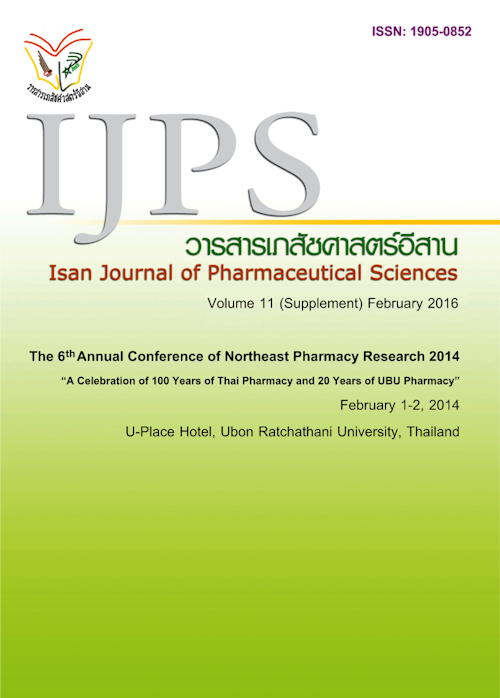Prescribing Pattern of Medicines for the Prevention of Diabetic Complications in District Hospitals
Main Article Content
Abstract
Introduction:Long-term complications of diabetes affect patients’ quality of life and health care costs. At present, medical evidence confirms effectiveness on prevention of vascular complications, both small and large blood vessels, of the use of angiotensin converting enzyme inhibitors (ACEIs) and angiotensin-2 receptor blockers (ARBs), statins and aspirin or clopidogrel. However, prescribing of these drugs was found to vary across hospitals. Materials and Method: Electronic prescribing and diagnosis data based on 18 standard files in 2011and 2012 from 46 district hospitals were analyzed for diabetic patients, using the SQL program. Semi-structured interview of nurse managers responsible for the hospital diabetes clinics was conducted. Results: Prescribing of drugs for diabetic complication prevention on average was: ACEIs/ARBs,38%; statins,40%; and aspirin orclopidogrel,38% and varied considerably across the study hospitals. The overall prescribing of ACEIs/ARBs and statins increased in 2012 despite hospital variations. Increased utilization was found in the hospitals that had internal medicine physicians, had a medical alert system for the drug requirement according to practice guidelines, and used the prescribing rate as hospital indicators for monitoring and evaluation. Conclusion: Thailand needs to assess the prescribing rate of drugs preventing diabetic complications. Increased utilization of these drugs should be advocated in all stakeholders.
Article Details
In the case that some parts are used by others The author must Confirm that obtaining permission to use some of the original authors. And must attach evidence That the permission has been included
References
American Diabetes Association. Standards of Medical Care in Diabetes-2012. Diabetes Care2012; 35(1): S11-63.
Aekplakorn W, Porapakkham Y, Taneepanichskul S, Pakcharoen H, Satheannoppakao P, Thaikla K, et al. The report of thailand population health examination survey IV 2008-2009. Nonthaburi: The graphics in the systems; 2010.
Cheawchanwattana A, Waleekhachonloet O, Rattanachotphannit T, Kitwitee P, Ullaman R, Saisunantararom W, et al. Qulity of Out-Patien Prescribing: An analysis of 18 standard file datasets of hospitals. Journal of Health Systems Research 2012; 6(2): 167-175.
Damin SI, Bailie R, Dowden M, Kennedy C, Cox R, O' Donoghue L, et al. Assessing quality of diabetes care and its variation in Aboriginal community health centres in Australia. Diabetes Metabol Res Rev2010; 26(6): 464-73.
Gulliford MC, Charlton J and Latinovic R. Trends in antihypertensive and lipid-lowering therapy in subjects with type II diabetes: clinical effectiveness or clinical discretion? Journal of Human Hypertension2005; 19:111-117.
Jaturapattarawong A, Butdeemee P, Boonjarat S, Apinun N, Supaluk W and Chanakit T. Diabetic disease management comparison among community hospitals in Ubonratchathani. Journal of Health Systems Research2011; 5(3): 332-343.
Prakongsai P, Tangcharoensathien V. Theestimation of investment in health in the10th National socio-economic development plan for health expenditure B.E. 2550-2554. Nonthaburi: The graphics in the systems; 2010.
Shaw JE, Sicree RA, Zimmet PZ. Global estimatesofthe prevalence of diabetes for 2010 and 2030. Diabetes Res Clin Pract 2010; 87: 4-14.


